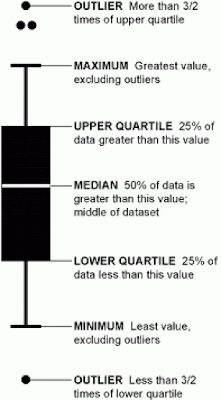Box -plot is one of the prominent feature important for TABLEAU Statistics section of Examination. Below is simple example to clarify the concept for the individuals new to it.
A small example should make things clear. Consider a small village with 25 inhabitants. This is what they earn and the resulting box plot:
|
Citizen Nr.
|
Income
|
Key Value
|
|
25
|
3,001.25
|
Maximum
|
|
24
|
2,996.45
|
|
|
23
|
2,919.35
|
|
|
22
|
2,787.02
|
|
|
21
|
2,784.72
|
|
|
20
|
2,696.83
|
|
|
19
|
2,412.51
|
Q3: 0.75 * 25 = 18.75 = 19.
|
|
18
|
2,400.43
|
|
|
17
|
2,367.84
|
|
|
16
|
2,333.37
|
|
|
15
|
2,285.53
|
|
|
14
|
2,214.87
|
|
|
13
|
2,069.79
|
Median: 0.5 * 25 = 12.5 = 13.
|
|
12
|
1,923.62
|
|
|
11
|
1,819.22
|
|
|
10
|
1,773.34
|
|
|
9
|
1,597.54
|
|
|
8
|
1,589.48
|
|
|
7
|
1,494.65
|
Q1: 0.25 * 25 = 6.25 = 7.
|
|
6
|
1,423.74
|
|
|
5
|
1,391.92
|
|
|
4
|
1,334.88
|
|
|
3
|
1,184.53
|
|
|
2
|
1,125.78
|
|
|
1
|
1,005.85
|
Minimum
|
As you can see, the basic idea is to sort the data and then select the minimum, the maximum and the values at the referring positions: median (0.5), lower (Q1) (0.25) and upper quartile (Q3) (0.75). Why these values are considered to be robust statistic key values? In order to explain this, consider a similar village with one rich person and the following incomes:
|
Citizen Nr.
|
Income
|
Key Value
|
|
24
|
10,345.67
|
Maximum
|
|
23
|
2,919.35
|
Upper Bound
|
|
22
|
2,787.02
|
|
|
21
|
2,784.72
|
|
|
20
|
2,696.83
|
|
|
19
|
2,412.51
|
|
|
18
|
2,400.43
|
Q3: (18. + 19.)/2 = 2,406.47
|
|
17
|
2,367.84
|
|
|
16
|
2,333.37
|
|
|
15
|
2,285.53
|
|
|
14
|
2,214.87
|
|
|
13
|
2,069.79
|
|
|
12
|
1,923.62
|
Median: (12. + 13.) / 2 = 1,996.71
|
|
11
|
1,819.22
|
|
|
10
|
1,773.34
|
|
|
9
|
1,597.54
|
|
|
8
|
1,589.48
|
|
|
7
|
1,494.65
|
|
|
6
|
1,423.74
|
Q1: (6. + 7.) / 2 = 1,459.2
|
|
5
|
1,391.92
|
|
|
4
|
1,334.88
|
|
|
3
|
1,184.53
|
|
|
2
|
1,125.78
|
|
|
1
|
1,005.85
|
Minimum / Lower Bound
|

No comments:
Post a Comment